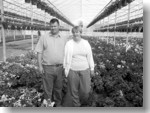November 1, 2001
Visiting Mike and Nancy Sym’s 79,000 square foot greenhouse operation at Delhi, Ontario, in October 2001, Gord Potts, General Manager of Norfolk District Business Development Corporation expresses a quiet satisfaction at the success of his former loan client of the NDBDC. “They started with 15,000 square feet of greenhouse space on five acres of land in 1988. Mike and his father and their families moved back to Delhi from Niagara on the Lake where they had been involved in greenhouse operations. They have steadily expanded the operation, and export 90 percent of their products to the United States.” Cheerfully greeting Gord, Mike Sym says, “Gord has had a lot to do with our success. If it hadn’t been for him we might still have been here now, but we’d be struggling. We used to curse you when you made us prepare those cash flows but now we wouldn’t undertake any project without going through that process.”
Getting a business off the ground involves putting up everything for security. Mike’s father was his partner at the start and is an important mentor even after the reorganization of the business six years ago. It is now owned by Mike and Nancy. Production is divided between poinsettias, chrysanthemums and cyclamens to ensure year-round cash flow. The business has seven employees and has achieved sales objectives for the past two years with 30 percent growth.
Part of the role of the community development corporation’s is to mentor their clients and guide them until they become “bankable”. Sometimes chartered banks are unable or unwilling to provide all the financing needs of a growing small-business, then the CDC may provide gap financing to enable the project to go ahead. Such was the case with Northview Greenhouses. Through the three cycles of growth and investment, NDBDC worked with the Sym's and their other financial sources to fashion the financing needed to achieve growth. Payments were flexible to accommodate cash flow and support the business.
“The biggest hurdle to overcome was getting the working capital we needed to grow. Now we’re focused on customer service. We’ll do just about anything for the customer. We want to give them value for their money so they can make money too and do more business with us. Now our biggest problem is deciding whether to expand or not, or whether to go more into retail. But these are good problems to have.” Mike Sym smiles.




